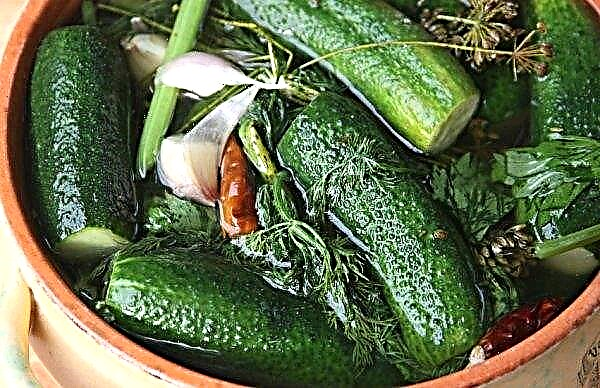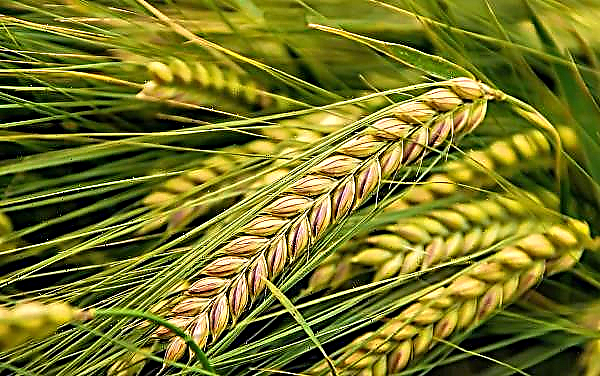Ficus mikrokarpa moklama, popular among lovers of home flowers, has an exquisite appearance. If you decide to grow this plant at home, it is worthwhile to understand in advance all the intricacies of caring for it.
Botanical description of the plant
Ficus moklama arrived in our latitudes from the tropics. The plant has the shape of a small bush with a dense stem covered with gray bark. Its height when grown in a flowerpot can reach a mark of 1.5 m. On shoots, leaves of a rounded oblong shape with a fleshy structure grow. The color of the foliage is bright green with a glossy tint.
During the flowering period, the ficus has small buds, the size of which on average is 1 cm in diameter. Also, the plant gives fruits that can not be eaten; they have the shape of berries and are distinguished by a bright red color.
Did you know? The second name of this ficus is "microcarp" has an ancient Greek origin and translates as "small seeds".
Benefit and harm
- Its useful properties include:
- purification of air from various fumes produced by products made of synthetic materials;
- therapy of joint diseases with decoctions and infusions based on ficus leaves, which can be used as an adjuvant.
When deciding to buy a flowerpot, you should pay attention to the possible harm of this plant. So, people prone to an allergic reaction, it is not worth it to start a ficus microcarp.
Growing conditions
For successful growth, ficus needs the right conditions, consisting in creating the optimal microclimate.
Accommodation
It is better to immediately place the flowerpot in a permanent place - a change of location and even rare movements often negatively affect the plant. The pot is best placed in a well-lit place, protected from sudden wind currents. In this case, the light should be scattered, since both its intense effect and the deficiency can adversely affect the state of the ficus.
Temperature mode
The optimum temperature in the room where the flowerpot is located should be within +17 ... + 24 ° С during warm seasons. At the onset of winter, the heat level can be reduced, but do not lower it below the + 16 ° С index. Sudden temperature changes are best avoided.
Did you know? Ficus Moklama in vivo can grow up to 25 m.
Air humidity
The moisture level in the air should be medium. Its indicators are best kept within 50–70%.
Home Care
Ficus moklama needs regular care. Particular attention should be paid to watering, fertilizing, transplanting and pruning.
Watering
The frequency of watering depends on the season: in winter, you should not moisten the soil more than 1 time in 14 days, and when it comes to heat, you need to water more often, approximately every 2-3 days. Water for irrigation should not be colder than room temperature.
Important! The main factor in this matter is the condition of the soil - it is important that it has time to dry for a few centimeters, and the water does not stagnate in its lower part.
Also, before the procedure, it must be defended for 1 day. It is better to avoid hard water. The best irrigation method is to irrigate the soil. In the heat, it is also necessary to spray the leaves with spray water.
Top dressing
Fertilize the plant during the period from March to August. In the spring, universal fertilizer will be the best option, and when summer begins, the soil must be enriched with fertilizing with a high nitrogen content. The frequency depends on the particular brand, so pay attention to the instructions for use.
Pruning
Pruning ficus moklama is needed in order to subsequently form a beautiful crown. It is easy to form a tree, since its branches and leaves are very plastic. To begin to form a ficus, it is necessary to wait until the main stem will have a height of at least 20 cm.First of all, you need to cut off the central shoot, and it is necessary to shorten the lateral stems after they reach the level of the main one.
Important! When cutting shoots, the plant secrete juice. It must be immediately wiped off and the cut-off spot treated with crushed activated carbon.
Transfer
It is better to transplant ficus moklama from March to August. For the first time, the procedure must be carried out after the purchase, and afterwards the frequency of transplantation should be 1 time in 2 years. The main thing is to look at the state of the plant. Young specimens can grow too quickly, so the container must be replaced for more than 1 time per year. The main factor determining the need for transplantation is the growth of the root system in such a way that the roots look through the hole for drainage or tightly braid the soil. The substrate can be prepared independently by mixing in equal proportions sheet soil, turf, sand and crushed coal. You can also purchase ready-made mixes in the store. The pot must be 4-5 cm larger than the previous one and have holes for drainage.
The substrate can be prepared independently by mixing in equal proportions sheet soil, turf, sand and crushed coal. You can also purchase ready-made mixes in the store. The pot must be 4-5 cm larger than the previous one and have holes for drainage.
The transplant process is as follows:
- Put drainage at the bottom of the new container (for example, from expanded clay).
- Pour a small layer of sand into the drainage.
- Carefully remove the ficus without removing soil from the root system.
- Move the plant to a new container.
- Pour rhizome to the level of the trunk with a new substrate.
Propagation at home
Ficus moklama propagated by cuttings. It is better to resort to the cuttings procedure from March to May - for this you need to cut off the top of the stem with a knife up to 15 cm long. The stem must be covered with bark and have 3 pairs of sheets. Next, the cut stalk needs to be rooted.
There are two ways to do this:
- Treat the slice with “Kornevin”, immerse the cuttings in a container with a substrate and put in place, illuminated with scattered light. After rooting, remove the leaves, leaving only 2 top sheets. After 14 days, fertilize the soil, and after 90 days, transplant ficus in a permanent pot.
- Cut the bottom leaves and shoots from the cuttings and place in a container with water. It is desirable that the container is not transparent. Top sheets on the handle should not touch water. Place the container with the stem in a warm place and spray for 2-3 weeks; after this period, the ficus should take root. Now it needs to be planted in a substrate; it is best to mix sand, peat and perlite in equal parts for it. After 3 months, the plant can be transplanted into a permanent pot.

Possible growing difficulties
Despite the unpretentiousness of ficus moklama, certain difficulties may arise when growing it.
Among the pests in this plant can be detected:
- aphid;
- scale shield;
- whitefly;
- mealybug;
- spider mite.
The development of some diseases is also possible:
- Rotting root. This symptom manifests itself as a result of improper irrigation and stagnation of water. The root must be cleaned of the affected areas and the soil treated with a fungicide, for example, carbendazim. In the future, you need to adjust the watering.
- Spots on the leaves. As is the case with rot on the roots, the cause is excessive watering. As a result, a fungal disease develops. The affected areas must be removed, then the ficus must be treated with a fungicide. For these purposes, "Topaz" or any other tool is suitable. You also need to reduce the humidity in the room and moderate the watering.
- Falling foliage. The reason, most likely, is a violation of the microclimate or improper watering. You should analyze the care of the plant and change the approach to its cultivation.
 For the good growth of this plant, it is necessary to take into account all its needs. And with proper care, the ficus microcarp Moklama is able to turn from a small bush into a beautiful tree.
For the good growth of this plant, it is necessary to take into account all its needs. And with proper care, the ficus microcarp Moklama is able to turn from a small bush into a beautiful tree.












